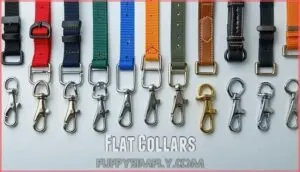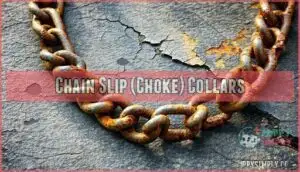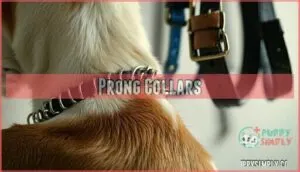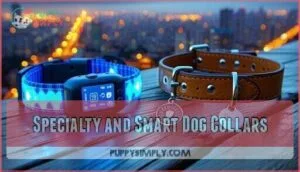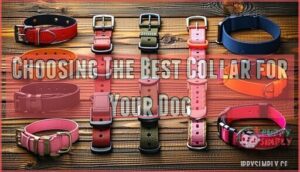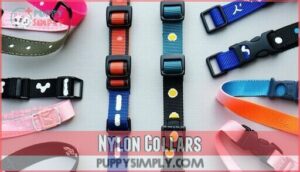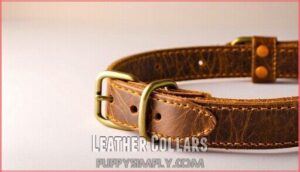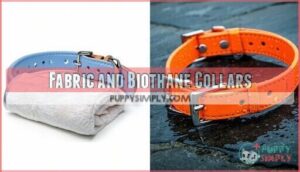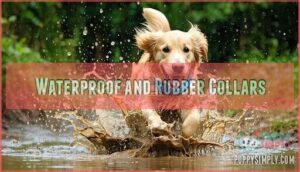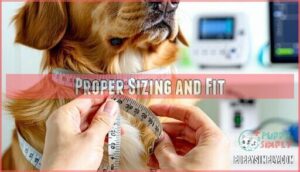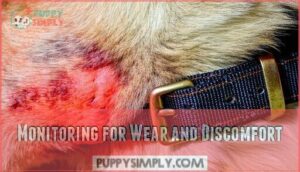This site is supported by our readers. We may earn a commission, at no cost to you, if you purchase through links.
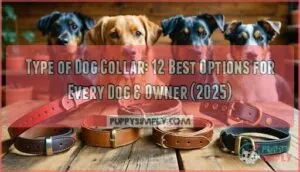
Got a master escape artist who slips out of everything? A lovable bulldozer who drags you down the sidewalk? Maybe a graceful sighthound with that delicate neck? There’s definitely a collar made just for your specific challenge.
Your options run the gamut—from basic everyday flat collars that work perfectly for most dogs to those fancy GPS trackers that can pinpoint your wandering explorer no matter where they’ve gotten to. Some are simple daily wear pieces, while others are serious training tools that need you to know what you’re doing.
Table Of Contents
- Key Takeaways
- Most Popular Types of Dog Collars
- Specialty and Smart Dog Collars
- Choosing The Best Collar for Your Dog
- Dog Collar Materials and Safety Tips
- Trends and Market Insights in Dog Collars
- Frequently Asked Questions (FAQs)
- What materials are best for dogs with skin allergies or sensitivities?
- How often should I check my dog’s collar for wear and tear?
- How often should I replace my dogs collar?
- Can collars cause hair loss or skin irritation?
- Whats the ideal collar width for different breeds?
- Are there collar alternatives for collar-sensitive dogs?
- How do I clean and maintain different collar types?
- Conclusion
Key Takeaways
- Start with flat collars for most dogs – they’re simple, safe, and work perfectly for everyday wear, ID tags, and well-behaved walkers without any complicated features or training requirements.
- Choose martingale collars if your dog pulls or escapes – they tighten gently to prevent slipping out while avoiding the choking hazards of traditional choke chains, making them ideal for sighthounds and escape artists.
- Consider harnesses for heavy pullers or neck-sensitive breeds – they distribute pressure across the chest instead of the delicate trachea, giving you better control while protecting your dog’s throat from injury.
- Skip shock and prong collars unless you’re working with a professional trainer – these tools can cause anxiety and aggression when misused, and positive reinforcement methods typically produce better long-term results without the safety risks.
Most Popular Types of Dog Collars
When you’re shopping for a dog collar, you’ll run into six main types. Each one tackles different training challenges and fits different dog body types.
Knowing these six options makes it easier to pick what works best for your dog’s size, behavior, and what you’re trying to teach them.
Flat Collars
Why settle for complicated when simple works best? Flat collars are the standard for everyday wear, featuring straightforward buckle types and secure closures. These classic dog collars offer a proper fit through adjustable sizing, making them perfect for ID tags and daily walks.
- Peace of mind: Your dog’s identification stays visible and secure
- Comfort first: Gentle pressure distribution prevents neck strain
- Built to last: Material durability means years of reliable use
Most flat dog collar options use nylon or leather construction. Regular cleaning methods keep them fresh—simply wipe down or hand wash as needed.
Martingale Collars
Martingale collars offer excellent sighthound safety by preventing escape artists from slipping free. You’ll find adjusting the fit straightforward—the secondary loop tightens gently when pulled, eliminating harsh choking.
Professional trainers love martingale collars for good reason. They work better than homemade versions because the pressure spreads out evenly instead of creating harsh pressure points.
Dog training becomes more effective while maintaining dog safety through controlled, humane correction.
Head Collars
Head Collars provide gentle leadership by applying pressure to your dog’s muzzle rather than their neck. These head halters work well for dogs who pull, though proper head collar fit requires gradual training integration for dog acceptance.
Consider these key factors:
- Gradual introduction – Allow 7-10 days for adjustment
- Proper positioning – Strap sits behind ears, not on neck
- Positive reinforcement – Reward calm behavior during wear
Alternative options include martingale collars if your dog resists head dog collars initially.
Chain Slip (Choke) Collars
You’ve probably seen chain slip collars—most people call them choke chains. Here’s how they work: when you pull the leash, the collar tightens around your dog’s neck. Some trainers still use them to correct bad behavior, but there’s a real problem here. These collars can seriously hurt your dog. We’re talking strangulation risks and actual damage to their throat.
Chain slip collars tighten around your dog’s neck when pulled, creating serious strangulation risks and potential throat damage
Research backs this up too. Dogs learn better with positive reinforcement methods, and you don’t have to worry about injuring them. If you absolutely must use a chain collar, get help from a professional trainer. But honestly? Try a martingale collar instead. You’ll get better control without the choking danger.
Prong Collars
Unlike gentler alternatives, prong collars (also called pinch collars) use metal prongs that apply pressure around your dog’s neck when pulled. These aversive tools require proper prong fitting and expert guidance to help guarantee humane prong usage.
- Metal prongs tightening like a gentle squeeze around the neck
- Immediate pressure release when your dog stops pulling forward
- Professional trainer demonstrating correct positioning and technique
- Alternative training collars sitting nearby as backup options
Prong collar effectiveness depends on correct application, but many veterinarians recommend exploring prong collar alternatives first for safer training outcomes.
Harnesses
Restraints redistribute pressure across your dog’s chest and shoulders instead of concentrating force on their delicate trachea. These dog restraint designs offer better control for pullers while protecting dog collar safety. Front-clip leash attachment points discourage pulling, while back-clip versions provide comfort for trained walkers.
| Restraint Types | Best For |
|---|---|
| Front-clip | Dogs who pull on walks |
| Back-clip | Well-trained, calm dogs |
| Dual-clip | Training integration flexibility |
| No-pull | Strong breeds needing control |
Most restraints feature adjustable straps accommodating various breed sizes. Look for padded chest plates and safety features like reflective strips for enhanced dog safety during evening walks.
Specialty and Smart Dog Collars
Modern collar tech has come a long way from basic leather straps. Today’s smart collars pack GPS tracking, activity monitors, and even training features into sleek designs that work as hard as your dog does.
These aren’t just fancy gadgets either. You’ve got specialty collars for every need—reflective ones for night walks, breakaway designs that release under pressure, and yes, even electronic training collars that help with stubborn behavioral issues when a pro trainer recommends them.
GPS and Smart Collars
Smart collars offer sophisticated GPS tracking technology that keeps your pup safe. These high-tech options feature activity tracking features, geofencing capabilities, and health monitoring. However, GPS battery life and data privacy concerns require consideration:
- Real-time location tracking with smartphone alerts
- Virtual boundary notifications when dogs roam
- Activity monitoring for exercise and health
- Smart collar accuracy within 3-10 feet
- Monthly subscription fees for cellular connectivity
For hunting dogs, a key feature is accurate GPS tracking over long distances.
Personalized Collars
Custom collars let you create something uniquely yours while keeping your dog safe. Custom engraving adds your pet’s name and your phone number directly onto the collar—no jingling tags needed. Reflective options boost nighttime visibility, while unique designs showcase your dog’s personality through vibrant colors and patterns.
| Feature | Benefit |
|---|---|
| Custom Engraving | Permanent identification that won’t fall off |
| Reflective Options | Enhanced visibility during evening walks |
| Unique Designs | Express your dog’s personality and style |
| Material Choices | Match durability needs with aesthetic preferences |
Style trends now include everything from leather with gold lettering to colorful nylon with fun graphics. These dog accessories combine function with fashion.
Breakaway and Safety Collars
Breakaway mechanisms in dog collars offer life-saving protection when conventional dog accessories become hazards. These collar alternatives feature buckles that release under pressure, preventing accidental strangulation if your dog gets caught on fences or other objects.
Many include reflective materials for enhanced visibility and secure ID placement that stays attached during accidental release. While they prioritize dog safety concerns, breakaway collars aren’t suitable for leash walks since they’ll detach when pulled.
Training Collars (Electronic, Vibrating)
Electronic and vibrating collars offer modern dog training tools but come with significant E-collar ethics concerns. Research shows positive reinforcement methods achieve better obedience without welfare risks. The effectiveness of electronic training aids remains a topic of debate among trainers. Understanding behavioral impact helps you make informed decisions.
Here’s what you should think about when looking at different training options:
- Vibrating collars provide gentler stimulation than shock options
- Misuse consequences include increased anxiety and aggression
- Professional guidance prevents improper ecollars usage
- Positive methods show greater long-term effectiveness
Training effectiveness depends on proper application and your dog’s temperament.
Choosing The Best Collar for Your Dog
Your dog’s breed, size, and behavior patterns determine which collar type will provide the safest and most effective control during walks and daily activities.
Consider your pet’s neck anatomy, pulling habits, and training needs when selecting from flat, martingale, or specialized collar options to guarantee proper fit and prevent tracheal damage.
Dogs Who Pull on Leash
Pulling behavior transforms peaceful walks into wrestling matches. You’ll need specialized equipment for dogs who treat leashes like tug-of-war ropes. Head halters redirect attention forward, while chest straps distribute pressure safely across the chest. Martingale collars prevent escape artists from backing out during Leash Training Tips sessions.
| Collar Type | Best For | Safety Note |
|---|---|---|
| Head Halters | Strong pullers | Requires gradual introduction |
| No-pull chest straps | Chest pressure distribution | Check for chafing regularly |
| Martingale collars | Escape prevention | Proper fit prevents choking |
Avoid Pinch collars without professional guidance—they can escalate anxiety.
Large or Powerful Breeds
Big dogs need serious gear that won’t snap under pressure. Large or Powerful Breed Training requires Heavy Duty Materials and Strong Leash Control to manage their strength safely.
- Martingale collars prevent escape without choking, ideal for breeds with thick necks
- Dog Chest Strap options distribute force across the chest, reducing neck strain
- Head Halters provide excellent control by redirecting the dog’s head movement
- Pinch collars offer precise correction when used properly by experienced handlers
- Breed Specific Collars with reinforced stitching withstand powerful pulling forces
Growing Puppies
Puppies grow fast, so you’ll need adjustable collars that accommodate their changing collar size during growth stages. Choose soft, lightweight options to prevent neck strain and guarantee a comfortable fit.
Start with a dog vest for puppy training walks—it’s gentler on developing necks. Schedule regular vet visits and health checks to monitor proper fit.
Remember, puppy socialization requires secure collars that won’t slip off during play.
Sighthounds and Slim-Necked Breeds
Protecting sighthounds and narrow head types requires understanding their breed-specific needs. Their delicate necks can slip out of flat collars easily, creating sighthound safety concerns.
- Martingale collars prevent escape while avoiding neck strain
- Chest straps distribute pressure away from fragile throats
- Specialty fittings accommodate their unique proportions
- Avoid slip collars that can cause tracheal damage in slim neck collars
Dogs in Training
Training your dog requires thoughtful collar selection to facilitate positive reinforcement and humane training methods. Flat collars work well for basic obedience exercises and puppy socialization, while martingale collars provide gentle leash control without choking.
Avoid prong or choke chains—studies show positive reinforcement training produces better results than punishment-based behavior correction, reducing anxiety while improving long-term compliance.
Dog Collar Materials and Safety Tips
You need to know about collar materials and what makes them safe. Pick the wrong one and you could end up with skin irritation, throat damage, or worse—collar accidents hurt over 26,000 dogs every year.
Getting the right materials and fit keeps your dog comfortable and safe while making sure the collar actually works when you need it to.
Nylon Collars
Choosing nylon for your dog’s collar delivers unbeatable nylon durability and pet comfort. These flat collars resist wear while remaining gentle against sensitive skin, reducing dog allergies concerns.
Nylon versatility means easy collar maintenance—just rinse and air dry. Unlike leather collars, they won’t crack or require conditioning.
When selecting collar size, nylon adjusts smoothly and holds its shape, making it ideal for active dogs who need reliable collar materials.
Leather Collars
Leather collars offer timeless style but require more attention than their nylon counterparts. The tanning process and leather types affect both collar durability and your dog’s comfort. Quality leather dog collars soften with age, making proper collar size and thickness selection important for long-term use.
Here’s what your leather collar needs:
- Clean with specialized leather conditioner monthly
- Check for cracking or rough edges that could irritate skin
- Allow proper drying time after wet weather exposure
- Replace when aesthetic options fade or structural integrity weakens
Fabric and Biothane Collars
Fabric collars offer breathable comfort for sensitive skin, while biothane combines fabric durability with waterproof materials for easy collar maintenance. Both eco-friendly options provide a comfortable fit compared to leather collars.
| Feature | Fabric Collars | Biothane Collars |
|---|---|---|
| Durability | Moderate wear resistance | Exceptional longevity |
| Maintenance | Machine washable | Simple wipe-clean |
| Comfort | Soft, breathable texture | Flexible, lightweight |
| Weather | Quick-dry capability | Fully waterproof |
| Cost | Budget-friendly option | Mid-range investment |
Biothane benefits include stain resistance and antimicrobial properties, making them ideal alternatives to traditional dog strap materials.
Waterproof and Rubber Collars
You’ll love waterproof materials and rubber durability when your pup splashes through puddles or rolls in mud. These dog collars offer exceptional collar maintenance benefits, staying fresh and odor-free with simple rinses.
- Exceptional rubber durability – withstands outdoor adventures and rough play
- Easy collar maintenance – rinse clean in seconds, no scrubbing required
- Enhanced dog comfort – flexible materials move naturally with your pet
- Rubber safety features – non-absorbent surface prevents bacterial growth
- All-weather performance – perfect for swimming, hiking, and rainy walks
Proper Sizing and Fit
Measure your dog’s neck circumference using a soft tape measure, adding two fingers’ width for proper collar adjustment techniques. Check sizing charts before purchasing—collar thickness affects neck comfort and prevents neck damage.
Test the fit by sliding two fingers between the collar and your dog’s neck. Proper dog collar selection ensures ideal dog health and safety while accommodating different neck sizes through careful collar measurement and fit testing.
Monitoring for Wear and Discomfort
Once you’ve got the right fit, regular collar inspection becomes your dog’s health insurance policy. Watch for material fatigue, fraying edges, and discomfort signs like excessive scratching or red marks on your dog’s neck.
- Check collar thickness weekly – worn spots compromise neck health
- Look for behavioral changes – head shaking signals irritation
- Inspect hardware daily – loose buckles risk escape emergencies
- Monitor neck skin condition – redness indicates potential neck damage
Trends and Market Insights in Dog Collars
You’re shopping in a rapidly evolving dog collar market that’s reached $6.1 billion globally, with premium smart collars and eco-friendly materials driving nearly 63% of current growth.
The shift toward online customization and GPS-enabled collars reflects pet owners’ increasing focus on safety technology and sustainable materials, making collar selection both more complex and more rewarding than ever before.
Growth of Eco-Friendly Materials
Over recent years, sustainable production has revolutionized dog collar materials. You’ll find recycled collars made from ocean plastics and biodegradable options crafted from hemp fibers. Green manufacturing processes now reduce environmental impact while maintaining durability for your pet’s safety needs.
| Material Type | Environmental Benefit |
|---|---|
| Recycled PET | 75% less energy usage |
| Hemp Fibers | 50% less water needed |
| Biodegradable | Decomposes in 5 years |
Premium and Tech-Enabled Collars
Why settle for basic when smart collars offer GPS tracking and sophisticated sensors? Premium materials like titanium and carbon fiber improve durability, while tech accessories provide real-time health monitoring.
Smart collar technology integrates seamlessly with smartphone apps, delivering location alerts and activity data. These GPS collars represent the cutting edge of pet safety innovation.
E-Commerce and Customization Trends
Online sales have revolutionized how you find pet accessories. E-commerce now accounts for 42% of collar purchases, with the market projected to reach $147.59 billion by 2030. Digital payments make buying custom designs easier than ever through consumer reviews.
- Smart collars and GPS collars dominate premium segments at checkout
- Customized collars drive 57% of customization requests online
- LED collars and designer options appeal to pet fashion enthusiasts
- Consumer reviews guide 61% of custom collar purchasing decisions
Frequently Asked Questions (FAQs)
What materials are best for dogs with skin allergies or sensitivities?
Choosing the wrong material could worsen your dog’s skin issues. You’ll want breathable, natural materials like leather, organic cotton, bamboo, and hemp.
Silicone, rubber, and stainless steel options also work well for sensitive skin.
How often should I check my dog’s collar for wear and tear?
Check your dog’s collar weekly for fraying, loose stitching, or worn hardware. Daily checks work better if your pup’s active outdoors or plays rough with other dogs.
How often should I replace my dogs collar?
Replace your dog’s collar every 12-18 months or sooner if you notice fraying, cracking, or loose hardware. Daily wear weakens materials over time, compromising safety and control during walks.
Can collars cause hair loss or skin irritation?
Yes, collars can cause hair loss and skin irritation if they’re too tight, worn constantly, or made from rough materials.
Rotate collar placement, make sure it fits well, and remove it occasionally to prevent rubbing and matting issues.
Whats the ideal collar width for different breeds?
Don’t think width’s just about looks—it’s about safety and comfort.
Small dogs need ¾-inch collars, medium dogs require 1-inch width, and large breeds need at least 1-inch, with giants requiring 5-2 inches for proper weight distribution .
Are there collar alternatives for collar-sensitive dogs?
Restraints distribute pressure across your dog’s chest instead of their neck, reducing strain and discomfort. Head halters offer gentle control by guiding your dog’s muzzle rather than applying neck pressure.
How do I clean and maintain different collar types?
Over 26,000 collar-related accidents happen yearly, making proper cleaning essential. Clean nylon collars weekly with dog shampoo, condition leather monthly with pet-safe products.
Conclusion
Picking the right dog collar doesn’t have to stress you out. Here’s the thing—most dogs do perfectly fine with a basic flat collar for daily walks and hanging around the house.
The trick is matching your collar choice to what your dog actually needs. Got a chill walker or a determined puller? Your training goals matter too. There’s a collar type out there that’ll keep both of you comfortable and safe, no matter what kind of adventures you’re heading out on.
- https://dogistry.com/blogs/news/types-of-dog-collars
- https://www.humaneworld.org/en/resources/dog-collars
- https://pmc.ncbi.nlm.nih.gov/articles/PMC11512810/
- https://www.futuremarketinsights.com/reports/dog-collars-market
- https://lovelaughwoof.com/2017/10/collar-safety-awareness-week-the-keepsafe-break-away-collar/

